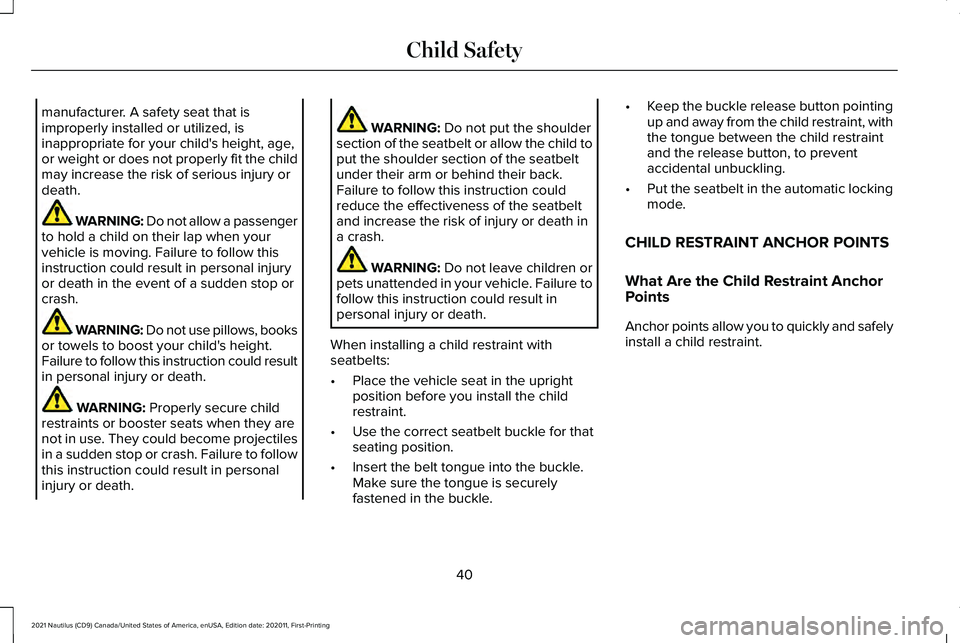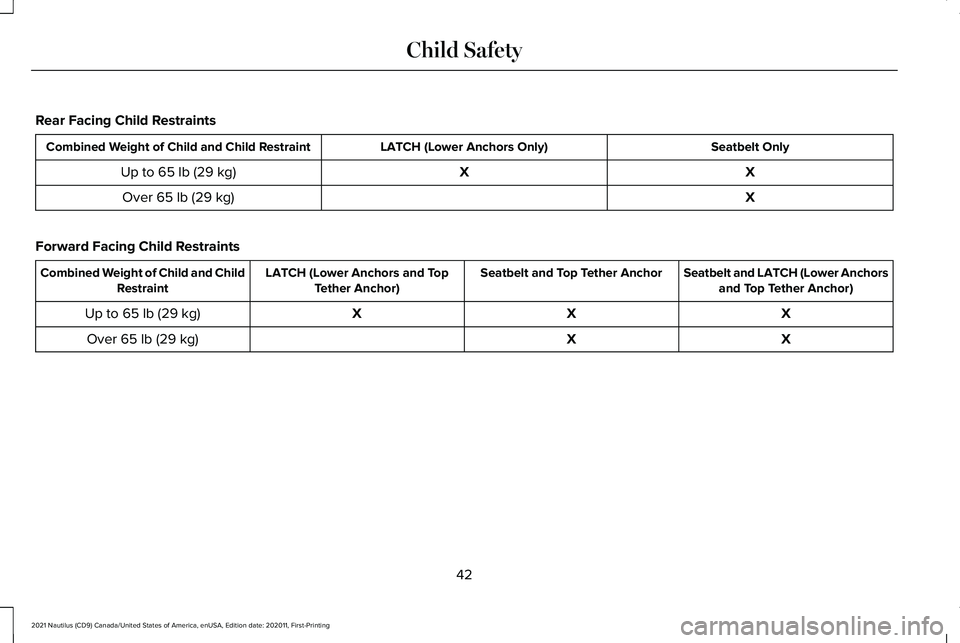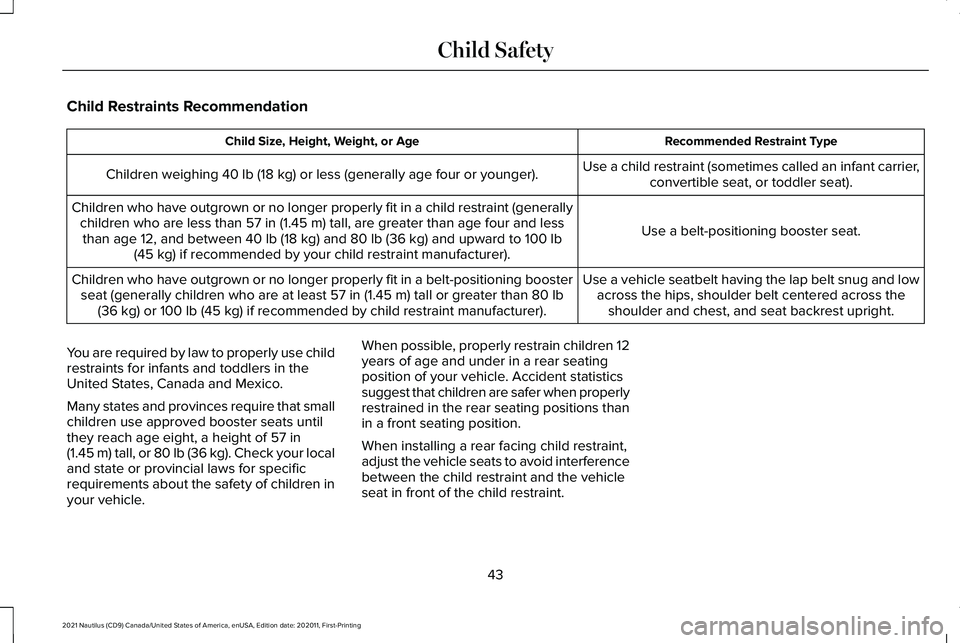2021 LINCOLN NAUTILUS belt
[x] Cancel search: beltPage 5 of 579

Contacting Us
Contacting Us
..................................................15
Introduction
About This Publication ..................................
17
Using This Publication ...................................
18
Symbols Glossary
Symbols Used on Your Vehicle ...................
19
Data Privacy
Data Privacy ....................................................
22
Service Data ....................................................
23
Event Data .......................................................
24
Settings Data ..................................................
24
Connected Vehicle Data .............................
25
Mobile Device Data ......................................
25
Emergency Call System Data .....................
26
Visual Search
Steering Wheel ...............................................
27
Instrument Panel ............................................
29
Center Console ...............................................
31Vehicle Interior
...............................................
33
Front Exterior ..................................................
35
Rear Exterior ....................................................
37
Child Safety
Child Safety Precautions .............................
39
Child Restraint Anchor Points .....................
40
Child Restraints ...............................................
41
Installing Child Restraints ............................
44
Booster Seats .................................................
49
Child Safety Locks .........................................
52
Seatbelts
Seatbelt Precautions ....................................
53
Fastening and Unfastening the Seatbelts ........................................................................\
.
54
Sensitive Locking Mode ..............................
55
Automatic Locking Mode ............................
55
Adjusting the Seatbelts During Pregnancy ........................................................................\
56
Adjusting the Seatbelt Height ....................
57
Seatbelt Reminder .........................................
57
Checking the Seatbelts ...............................
60Seatbelt Extensions
......................................
60
Personal Safety System ™
What Is the Personal Safety System .........
62
How Does the Personal Safety System Work .............................................................
62
Personal Safety System Components ........................................................................\
62
Airbags
How Do the Front Airbags Work ...............
63
How Do the Side Airbags Work .................
63
How Do the Knee Airbags Work ...............
64
How Does the Safety Canopy™ Work .......
65
Airbag Precautions ........................................
66
Properly Adjusting the Driver and Front Passenger Seats ........................................
67
Children and Airbags ....................................
67
Front Passenger Sensing System .............
67
Crash Sensors and Airbag Indicator ..........
71
Disposing of Airbags .....................................
72
911 Assist
How Does 911 Assist Work ..........................
73
1
2021 Nautilus (CD9) Canada/United States of America, enUSA, Edition date: 202011, First-Printing Table of Contents
Page 15 of 579

Recreationally Towing Your Vehicle - 2.0L,
FWD .............................................................314
Recreationally Towing Your Vehicle - 2.7L .......................................................................
314
Emergency Towing ......................................
315
Fuses
Fuse Precautions ..........................................
316
Under Hood Fuse Box ................................
316
Body Control Module Fuse Box ..............
326
Identifying Fuse Types ................................
331
Fuses – Troubleshooting ...........................
331
Maintenance
Maintenance Precautions .........................
332
Opening and Closing the Hood ..............
332
Under Hood Overview - 2.0L ...................
334
Under Hood Overview - 2.7L ...................
336
Engine Oil ......................................................
338
Checking the Coolant ................................
340
Changing the Engine Air Filter .................
344
Changing the Fuel Filter ............................
344
Drive Belt Routing Overview - 2.0L ........
345Drive Belt Routing Overview - 2.7L
.........
345
Changing the 12V Battery .........................
345
Adjusting the Headlamps ..........................
348
Exterior Bulbs ...............................................
350
Interior Bulbs ................................................
353
Vehicle Care
Cleaning Products .......................................
354
Cleaning the Exterior .................................
355
Waxing ............................................................
357
Cleaning the Interior ...................................
357
Repairing Minor Paint Damage ................
359
Body Styling Kits
Body Styling Kit Precautions ....................
360
Storing Your Vehicle
Preparing Your Vehicle for Storage .........
361
Removing Your Vehicle From Storage ......................................................................
362
Wheel and Tire Information
Locating the Tire label ...............................
363Department of Transportation Uniform Tire
Quality Grades .........................................
363
Information on the Tire Sidewall .............
364
Glossary of Tire Terminology ...................
369
Tire Replacement Requirements ............
369
Using Snow Chains .....................................
372
Tire Care
Checking the Tire Pressures ....................
374
Inflating the Tires .........................................
374
Inspecting the Tire for Wear .....................
375
Inspecting the Tire for Damage ...............
375
Inspecting the Wheel Valve Stems .........
376
Tire Rotation .................................................
376
Tire Sealant and Inflator Kit
What Is the Tire Sealant and Inflator Kit ......................................................................
378
Tire Sealant and Inflator Kit Precautions ......................................................................
378
Locating the Tire Sealant and Inflator Kit ......................................................................
378
Tire Sealant and Inflator Kit Components ......................................................................
379
11
2021 Nautilus (CD9) Canada/United States of America, enUSA, Edition date: 202011, First-Printing Table of Contents
Page 23 of 579

SYMBOLS USED ON YOUR
VEHICLE
These are some of the symbols you may see
on your vehicle.
Air conditioning system
Air conditioning system lubricant
type
Anti-lock braking system
Avoid smoking, flames or sparks
Battery
Battery acid
Brake fluid - non petroleum based Brake system
Brake system
Cabin air filter
Check fuel cap
Child safety door lock or unlock
Child seat lower anchor
Child seat tether anchor
Cruise control
Do not open when hot Electric Parking brake
Engine air filter
Engine coolant
Engine coolant temperature
Engine oil
Explosive gas
Fan warning
Fasten seatbelt
Flammable
Front airbag
19
2021 Nautilus (CD9) Canada/United States of America, enUSA, Edition date: 202011, First-Printing Symbols GlossaryE162384 E231157 E270480 E332905 E71880 E231160 E67017
Page 26 of 579

WARNING: Do not connect wireless
plug-in devices to the data link connector.
Unauthorized third parties could gain
access to vehicle data and impair the
performance of safety related systems.
Only allow repair facilities that follow our
service and repair instructions to connect
their equipment to the data link connector.
We respect your privacy and are committed
to protecting it. The information contained
in this manual was correct at the time of
publication but as technology rapidly
changes, we recommend that you visit the
local Lincoln website for the latest
information.
Your vehicle has electronic control units that
have data recording functionality and the
ability to permanently or temporarily store
data. This data could include information on
the condition and status of your vehicle,
vehicle maintenance requirements, events
and malfunctions. The types of data that can
be recorded are described in this section.
Some of the data recorded is stored in event
logs or error logs. Note:
Error logs are reset following a service
or repair.
Note: We may provide information in
response to requests from law enforcement,
other government authorities and third
parties acting with lawful authority or through
a legal process. Such information could be
used by them in legal proceedings.
Data recorded includes, for example:
• Operating states of system components,
for example fuel level, tire pressure and
battery charge level.
• Vehicle and component status, for
example wheel speed, deceleration,
lateral acceleration and seatbelt status.
• Events or errors in essential systems, for
example headlamps and brakes.
• System responses to driving situations,
for example airbag deployment and
stability control.
• Environmental conditions, for example
temperature. Some of this data, when used in combination
with other information, for example an
accident report, damage to a vehicle or
eyewitness statements, could be associated
with a specific person.
Services That We Provide
If you use our services, we collect and use
data, for example account information,
vehicle location and driving characteristics,
that could identify you. We transmit this data
through a dedicated, protected connection.
We only collect and use data to enable your
use of our services to which you have
subscribed, with your consent or where
permitted by law. For additional information,
see the terms and conditions of the services
to which you have subscribed.
For additional information about our privacy
policy, refer to the local Lincoln website.
22
2021 Nautilus (CD9) Canada/United States of America, enUSA, Edition date: 202011, First-Printing Data Privacy
Page 28 of 579

EVENT DATA
This vehicle is equipped with an event data
recorder. The main purpose of an event data
recorder is to record, in certain crash or near
crash-like situations, such as an airbag
deployment or hitting a road obstacle; this
data will assist in understanding how a
vehicle
’s systems performed. The event data
recorder is designed to record data related
to vehicle dynamics and safety systems for
a short period of time, typically 30 seconds
or less.
The event data recorder in this vehicle is
designed to record such data as:
• How various systems in your vehicle
were operating.
• Whether or not the driver and passenger
seatbelts were buckled/fastened.
• How far (if at all) the driver was
depressing the accelerator and/or the
brake pedal.
• How fast the vehicle was traveling.
• Where the driver was positioning the
steering wheel. This data can help provide a better
understanding of the circumstances in which
crashes and injuries occur.
Note:
Event data recorder data is recorded
by your vehicle only if a non-trivial crash
situation occurs; no data is recorded by the
event data recorder under normal driving
conditions and no personal data or
information (for example name, gender, age,
and crash location) is recorded. However,
parties, such as law enforcement, could
combine the event data recorder data with
the type of personally identifying data
routinely acquired during a crash
investigation.
To read data recorded by an event data
recorder, special equipment is required, and
access to the vehicle or the event data
recorder is needed. In addition to the vehicle
manufacturer, other parties, such as law
enforcement, that have such special
equipment, can read the information if they
have access to the vehicle or the event data
recorder. SETTINGS DATA
Your vehicle has electronic control units that
have the ability to store data based on your
personalized settings. The data is stored
locally in the vehicle or on devices that you
connect to it, for example, a USB drive or
digital music player. You can delete some of
this data and also choose whether to share
it through the services to which you
subscribe.
Comfort and Convenience Data
Data recorded includes, for example:
•
Seat and steering wheel position.
• Climate control settings.
• Radio presets.
Entertainment Data
Data recorded includes, for example:
• Music, videos or album art.
• Contacts and corresponding address
book entries.
• Navigation destinations.
24
2021 Nautilus (CD9) Canada/United States of America, enUSA, Edition date: 202011, First-Printing Data Privacy
Page 44 of 579

manufacturer. A safety seat that is
improperly installed or utilized, is
inappropriate for your child's height, age,
or weight or does not properly fit the child
may increase the risk of serious injury or
death.
WARNING: Do not allow a passenger
to hold a child on their lap when your
vehicle is moving. Failure to follow this
instruction could result in personal injury
or death in the event of a sudden stop or
crash. WARNING: Do not use pillows, books
or towels to boost your child's height.
Failure to follow this instruction could result
in personal injury or death. WARNING: Properly secure child
restraints or booster seats when they are
not in use. They could become projectiles
in a sudden stop or crash. Failure to follow
this instruction could result in personal
injury or death. WARNING:
Do not put the shoulder
section of the seatbelt or allow the child to
put the shoulder section of the seatbelt
under their arm or behind their back.
Failure to follow this instruction could
reduce the effectiveness of the seatbelt
and increase the risk of injury or death in
a crash. WARNING:
Do not leave children or
pets unattended in your vehicle. Failure to
follow this instruction could result in
personal injury or death.
When installing a child restraint with
seatbelts:
• Place the vehicle seat in the upright
position before you install the child
restraint.
• Use the correct seatbelt buckle for that
seating position.
• Insert the belt tongue into the buckle.
Make sure the tongue is securely
fastened in the buckle. •
Keep the buckle release button pointing
up and away from the child restraint, with
the tongue between the child restraint
and the release button, to prevent
accidental unbuckling.
• Put the seatbelt in the automatic locking
mode.
CHILD RESTRAINT ANCHOR POINTS
What Are the Child Restraint Anchor
Points
Anchor points allow you to quickly and safely
install a child restraint.
40
2021 Nautilus (CD9) Canada/United States of America, enUSA, Edition date: 202011, First-Printing Child Safety
Page 46 of 579

Rear Facing Child Restraints
Seatbelt Only
LATCH (Lower Anchors Only)
Combined Weight of Child and Child Restraint
X
X
Up to 65 lb (29 kg)
X
Over
65 lb (29 kg)
Forward Facing Child Restraints Seatbelt and LATCH (Lower Anchors
and Top Tether Anchor)
Seatbelt and Top Tether Anchor
LATCH (Lower Anchors and Top
Tether Anchor)
Combined Weight of Child and Child
Restraint
X
X
X
Up to
65 lb (29 kg)
X
X
Over
65 lb (29 kg)
42
2021 Nautilus (CD9) Canada/United States of America, enUSA, Edition date: 202011, First-Printing Child Safety
Page 47 of 579

Child Restraints Recommendation
Recommended Restraint Type
Child Size, Height, Weight, or Age
Use a child restraint (sometimes called an infant carrier,convertible seat, or toddler seat).
Children weighing 40 lb (18 kg) or less (generally age four or younger).
Use a belt-positioning booster seat.
Children who have outgrown or no longer properly fit in a child restrain\
t (generally
children who are less than
57 in (1.45 m) tall, are greater than age four and less
than age 12, and between 40 lb (18 kg) and 80 lb (36 kg) and upward to 100 lb
(45 kg) if recommended by your child restraint manufacturer).
Use a vehicle seatbelt having the lap belt snug and lowacross the hips, shoulder belt centered across theshoulder and chest, and seat backrest upright.
Children who have outgrown or no longer properly fit in a belt-positioni\
ng booster
seat (generally children who are at least
57 in (1.45 m) tall or greater than 80 lb
(36 kg) or 100 lb (45 kg) if recommended by child restraint manufacturer).
You are required by law to properly use child
restraints for infants and toddlers in the
United States, Canada and Mexico.
Many states and provinces require that small
children use approved booster seats until
they reach age eight, a height of
57 in
(1.45 m) tall, or 80 lb (36 kg). Check your local
and state or provincial laws for specific
requirements about the safety of children in
your vehicle. When possible, properly restrain children 12
years of age and under in a rear seating
position of your vehicle. Accident statistics
suggest that children are safer when properly
restrained in the rear seating positions than
in a front seating position.
When installing a rear facing child restraint,
adjust the vehicle seats to avoid interference
between the child restraint and the vehicle
seat in front of the child restraint.
43
2021 Nautilus (CD9) Canada/United States of America, enUSA, Edition date: 202011, First-Printing Child Safety